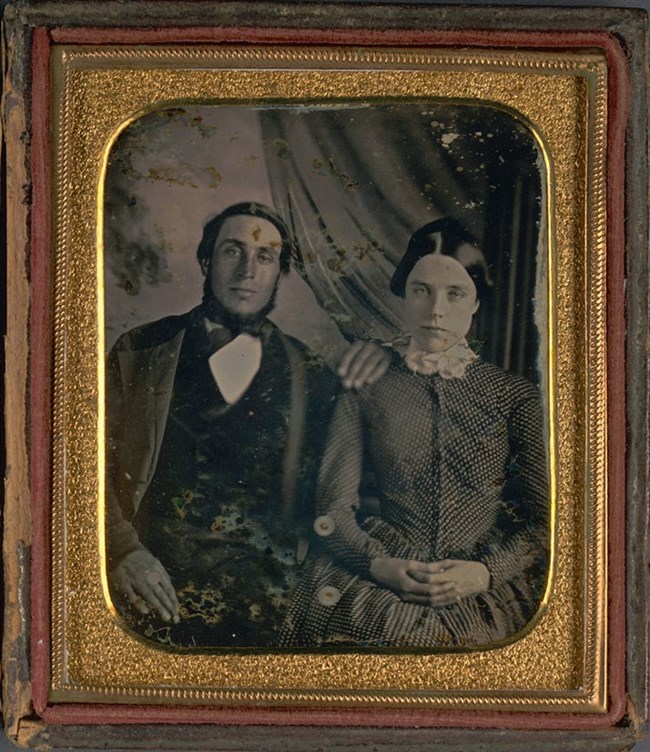Part of a series of articles titled Women's History in the Pacific West - California-Great Basin Collection.
Previous: Piu-uina
Next: Mary Lange
Article

William Edgar Randall family photographs, BANC PIC 1955.011:002-CASE, Bancroft Library, University of California, Berkeley.
Sarah Seaver Randall came to California for gold and became a prolific landowner and dairy farmer in Marin County’s Olema Valley. Following the murder of her husband William E. Randall in 1860, she raised five children alone, expanded her family’s ranch, and developed a successful model for commercial dairy sales. The two-story Victorian home she built in 1880 is contained within the Point Reyes National Seashore, where it is home to the rare Townsend’s big-eared bat and the enduring memory of a woman who crossed the continent and eventually found economic security.1
Sarah Seaver was born in East Craftsbury, Vermont in 1826.2 She married William E. Randall, also a Vermonter, in 1849 and headed west as a part of the California Gold Rush. Their trip aboard the ship Hannibal, which docked in San Francisco in May 1850, lasted 163 days.3 In 1853 the Randalls moved to San Jose, and shortly afterwards relocated to Oregon with William Randall’s longtime business partner John Nelson. In Oregon the Randalls and Nelson acquired a herd of dairy cattle and moved back to California in 1857, this time to Olema Valley, where they purchased 1,400 acres of farmland.4 Nelson sold his portion of the land in 1860, but the Randall family, now with five children, lived on a farmstead with Sarah Randall’s two sisters and her brother as well as two oxen, four horses, thirty-two milk cows, forty beef cattle, and nine pigs. By all accounts, their life was idyllic except for the presence of their neighbor, Benjamin Miller. The rancher had long envied their land, which produced potatoes, honey, and butter, and he often tore down the fences that divided their properties to let his animals graze in the Randalls’ pasture. As of 1860, the Randalls had in a few years made improvements to 300 acres of their parcel.5
On the morning of June 7, 1860 William Randall and Daniel Seaver met neighbor Benjamin Miller and his son in their pasture as they attempted to drive Miller’s cattle off their property. Miller and his son were armed with a rifle and shotgun. The men had a dispute that prompted Randall to brandish his own pistol, which resulted in Miller shooting him in the abdomen.6 Randall was fortunate to receive medical attention the same day; however, due to the severity of his wounds, he died that evening.7
Over the next two years, Sarah Randall continued to raise her five young children and manage the Randall property. In 1862, she was involved in another, more formal, land dispute. The Shafter family, who owned a berry farm on the parcel of land bordering hers, claimed that the property sold to the Randall family had been mismeasured and that her ranch and home encroached on their pasture. She took her land claim to court, where her neighbor to the north, Daniel Olds Jr., testified that she was “very industrious and devotes herself incessantly to the care of her family and the conduct of her dairy operation. She knows as little about legal matters as the majority of American matrons.”8 His statement about her legal incompetence was untrue, but it persuaded the judge that Randall should be permitted to remain on her property.
Randall kept a diary to record her industry. In 1864, she wrote that her family experienced a particularly nice winter and noted she was milking eighteen dairy cows.9 In 1866, she decided to expand her property and purchased a portion of an adjoining ranch.10 In the 1870 census she was listed as the Head of Household.11 That year, the Randall dairy produced 5,000 pounds of butter, with 3,000 pounds credited to Randall herself.12 She also harvested oats, wheat, and hay. In 1880, she built the Victorian house where she lived out most of the rest of her life.
In 1907, she succumbed to illness and died in the home of her daughter Fannie J. Tuller. The local newspaper remembered her as “a woman of sterling character. One of the noblest and truest women to ever live.”13 She left the products of her years of work and perseverance--ranch, the dairy, a fruit drying plant, and substantial house--to her children.14 The ranch was sold to the federal government in 1974 and has since been transferred into the care of the Point Reyes National Seashore.15
Part of a series of articles titled Women's History in the Pacific West - California-Great Basin Collection.
Previous: Piu-uina
Next: Mary Lange
Last updated: February 22, 2022